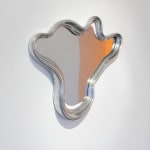Marija Puipaitė Lithuanian, b. 1987
Collaboration with Vytautas Gečas: Romance & Gravity (Mirror) , 2019
Aliuminis, nerūdijantis plienas / Aluminum, stainless steel
76 x 105 x 9 cm
Edition of 8 plus 2 AP
Further images
Please note: Gamybos laikas 4–8 savaitės. Galime pagaminti ir pagal užsakymą: dėl bet kokių pageidavimų susisiekite su mumis. / Production time 4 - 8 weeks. Made to order creations can...
Please note: Gamybos laikas 4–8 savaitės. Galime pagaminti ir pagal užsakymą: dėl bet kokių pageidavimų susisiekite su mumis. / Production time 4 - 8 weeks. Made to order creations can be done: please contact us for any request.
Photo: Laurynas Skeisgiela // In 2018 during their residency at the Cité Internationale des Arts in Paris, the contextual design duo of Marija Puipaitė and Vytautas Gečas began artistic research into the decor. Taking as their point of reference the idea that the Baroque epoch at its outset was associated with something ‘peculiar and unnecessarily complicated’, they linked it to the depreciation of decor in our everyday environment. While analyzing historical artifacts and techniques, they focused on the actualization of decor and its possible manifestations in the context of contemporary design.
Marija Puipaitė and Vytautas Gečas employed such decorative elements as frames and folds and transformed them into autonomous, almost conscious functional works. The mirror frame, which itself became a mirror, and the dresser, inspired by racing technology, display motifs of deformation and fluidity, as if their form was shaped by time and speed.
Photo: Laurynas Skeisgiela // In 2018 during their residency at the Cité Internationale des Arts in Paris, the contextual design duo of Marija Puipaitė and Vytautas Gečas began artistic research into the decor. Taking as their point of reference the idea that the Baroque epoch at its outset was associated with something ‘peculiar and unnecessarily complicated’, they linked it to the depreciation of decor in our everyday environment. While analyzing historical artifacts and techniques, they focused on the actualization of decor and its possible manifestations in the context of contemporary design.
Marija Puipaitė and Vytautas Gečas employed such decorative elements as frames and folds and transformed them into autonomous, almost conscious functional works. The mirror frame, which itself became a mirror, and the dresser, inspired by racing technology, display motifs of deformation and fluidity, as if their form was shaped by time and speed.








